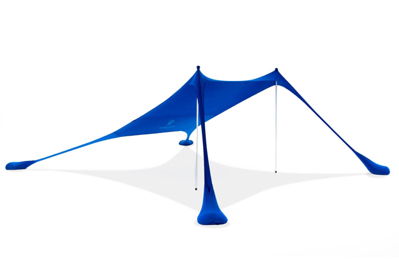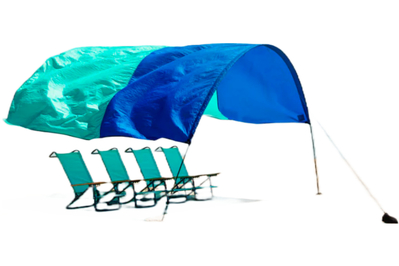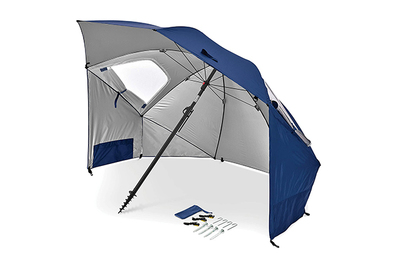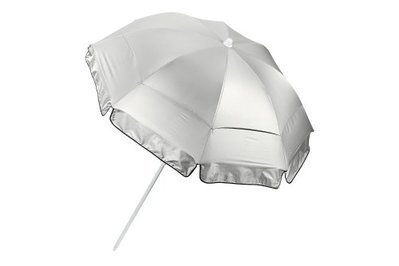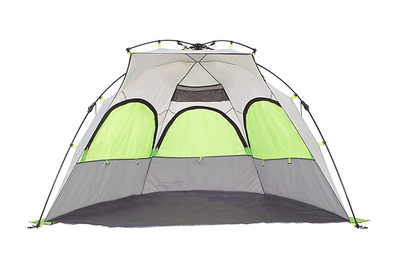On top of that, even if your umbrella does remain stationary, you spend most of your day chasing the meager, postage-stamp-sized patch of shade it provides as if you’re some deranged sundial.
There is a better way: the sunshade.
A good sunshade provides consistent protection from the sun over a large area while maintaining a comfortable amount of headroom. It should be easy to carry, intuitive to set up, and sturdy in the wind without collapsing.
Of the seven shades we tested, our two favorites, the Sun Ninja Tent 4 Person and the Shibumi Shade, meet those demands but suit different circumstances. The Sun Ninja shade requires plenty of beach space but tolerates variable wind conditions. While the Shibumi model maximizes your shade without intruding on close neighbors, it requires a steady coastal wind to function—and it costs more.
Recently, counties in New Jersey and New York State, among others, have banned this kind of tent and shade. Maybe it’s something we should have seen coming. Canopies and tents do take up a larger footprint on already crowded beaches—especially if they’re used inconsiderately or irresponsibly.
In case the beaches you visit have such rules, we’ve included in this guide two smaller tent-like options, as well as an umbrella we’ve recommended in the past. Also, we plan to retest some traditional stand-up umbrellas that are suitable for beaches with even stricter rules.
Our pick
Sun Ninja Tent 4 Person
When you have plenty of space on the beach, this stretchable spandex canopy is easy to set up and offers great sun protection in variable winds. However, it commands a fairly large chunk of the beach, which might annoy your neighbors.
Remarkably consistent in a variety of wind conditions, the Sun Ninja Tent 4 Person is pleasant to sit under—no matter how strong the sun—and packs away into a small carrying case that’s easy to throw over your shoulder (it weighs just over 7 pounds).
The spandex canopy is dead simple to set up: Stretch the four arms of the fabric out across the beach, fill the large pouch at the end of each arm with plenty of sand, and then place the four collapsible aluminum rods under the canopy, raising and angling them into the top corners of the tent until you find the best balance of tensions. The whole process can take one or two people less than three minutes, once they know what they’re doing.
Erected, the Sun Ninja Tent provides plenty of shade for four people to comfortably lie down in. (The company also offers an eight-person model for even more space.) In low and moderate winds, the flexibility of the Sun Ninja shade allows it to shake off most gusts up to 15 mph without falling over. Sitting under the tent feels almost bedouin in nature, an experience in nomadic self-contentment.
That said, the Sun Ninja Tent’s stretched-out design unavoidably occupies quite a bit of beach in relation to the 7-by-7-foot piece of shade it creates, which other folks might not appreciate if you frequent crowded beaches.
Upgrade pick
Shibumi Shade
With a beguiling, minimal design, this shade is easy and quick for one person to set up. As long as a steady wind blows, the fabric floats above you, providing enough sun coverage for six people without buckling or collapsing.
If your favorite beach features steady offshore breezes—or even umbrella-tumbling gusts—the Shibumi Shade is a natural choice. Instead of resisting the wind, the Shibumi Shade’s wonderfully simple design puts it to work—which makes sense, considering that the shade was conceived on the blustery beaches of North Carolina’s Outer Banks.
The shade has three components: a long arc of high-strength aluminum tubing (it folds up like a tent pole), a roughly 16-by-8-foot rectangle of parachute fabric, and a sand anchor, which doubles as the shade’s carrying case. One person can set it up in a minute or two.
We tested the Shibumi Shade in everything from barely perceptible ocean breezes to stiff 25 mph winds, and it worked admirably, providing about 10 by 15 feet of shade—enough for six adults—when the sun was high. (If you don’t need quite as much coverage, the similarly constructed Shibumi Shade Mini is designed for one person or a couple.) High winds produce more noise than one might expect. On most days, though, with a gentle onshore breeze, sitting under the Shibumi Shade is like lying under a crisp sheet hanging on a clothesline in the summer sun.
While this shade is more expensive than our other picks, the quality of its materials—from the aluminum poles usually reserved for high-end camping tents to the parachute fabric—all but ensure that this shade will be around for many more summers than your typical beach umbrella or tent.
Budget pick
Sport-Brella Premiere
This easy-to-set-up shade features the basic design of a beach umbrella but adds tent flaps for more protection from both sun and mild wind. It also has a vent and comes with stakes and sandbags to help keep it from blowing away in stronger gusts.
If you prefer to also have at least some protection from the wind, you could try the Sport-Brella Premiere, our longtime recommendation for people seeking a beach umbrella.
It looks like a typical umbrella tipped on its side, with flaps added to block more of the wind and sun. Two people fit easily underneath it, yet its footprint is moderate, making it a good choice for a crowded beach.
You do need to anchor it with stakes and sandbags to keep it from pinwheeling away on a blustery day; it has vents that you can open to help reduce some of the drag, though that will, of course, let in some wind.
It’s also heavier (thanks to its steel pole) and bulkier than either the Sun Ninja Tent or the Shibumi Shade—even when folded up, the Sport-Brella Premiere was too long, at 40 inches, to fit in one tester’s trunk.
Also great
Coolibar Intego Beach Umbrella
This lightweight umbrella made of higher-quality materials than cheaper models is a good choice if you don’t want extra straps and flaps or if your chosen beach allows nothing but traditional umbrellas.
Not all classic beach umbrellas are built alike, and you very much get what you pay for in this category. If you’re looking for a stand-up umbrella that can beat the heat and the wind, we recommend the Coolibar Intego Beach Umbrella.
It weighs just 4 pounds, folds into a slim nylon bag, and opens to offer 6 feet of coverage, which is enough shade for two people. However, with a reflective outer layer, the Coolibar Intego umbrella creates a deep shade from the sun, and the underside, which is made almost entirely from metal, is sturdy in stronger winds.
However, this umbrella is not height adjustable—once it’s locked in, you have to dig it deeper into the sand to lower it. And like all umbrellas of this design, it has no anchor or auger for securing it into the sand. (We’re testing items in both categories and will have additional picks soon.)
Also great
Lightspeed Outdoors Bahia Quick Draw
This polyurethane canopy sets up in seconds to provide shade and a windscreen for two adults, and it packs up smaller than any other tent-style shelter we’ve tested.
Like the Sport-Brella Premiere, the Lightspeed Outdoors Bahia Quick Draw is meant to block wind and sun alike.
And initially the Bahia Quick Draw is indeed quick to set up—quicker than the Sport-Brella shade, at least in theory. You unfold and lay out the shelter’s floor, locate the top of the pole assembly, and pull the two cords; the poles pop out into place, followed by the attached water-resistant polyurethane shell.
However, if wind is what you hope to hide from, you also need to stake down the three corners, stabilize the overhang that juts out over the shelter’s opening, and weigh down the base with three sandbags—not quite as quick or easy a process as the name implies. Just don’t expect it to stand up to a windstorm.


